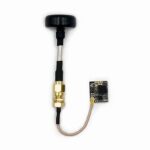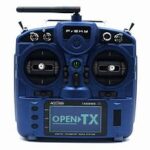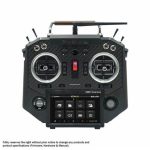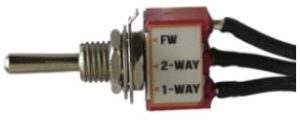
Instruction Manual for DHT
Introduction
Description and compatibility


Specifications
Dimension: 55*34*8mm (2.17”L x 1.34”W x 0.32”T)
Operating Voltage Range: 6.0V-13.0V
Operating Current: 50mA
Output Power: 60mW
Resolution: 3072 (>11bit)
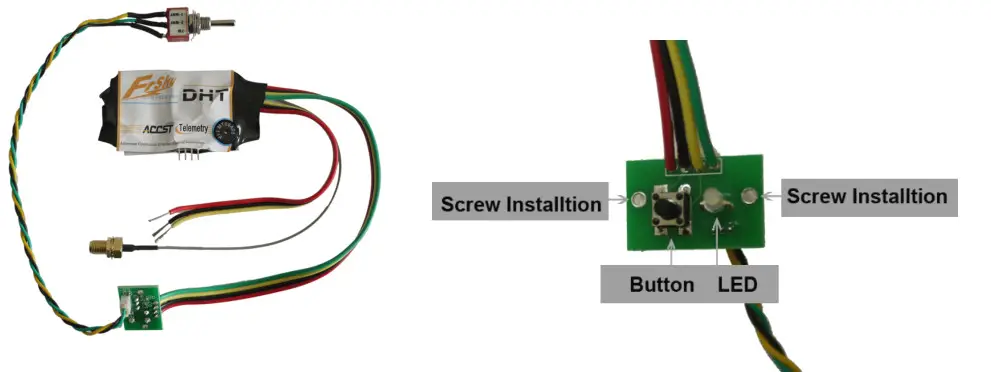
SetUp
Installation process
- Open the transmitter and find a clear position to locate the DHT module, the antenna connector, the small electronic panel. The location of the antenna should be such that there is no metal touching the antenna after it is mounted.
- Locate the battery power supply line, GND and PPM signal line. These are often a three-wire bundle or ribbon cable connected to a separate transmitter circuit card. Use a voltmeter and/or oscilloscope to help identify the function of each wire. (RED→V+; BLACK→GND; YELLOW→PPM)
- Drill four holes on the transmitter as the picture guided, two holes on both sides are designed for screw installation, others for green/red color LED and the button. (see picture above ); then drill another hole for installing toggle switch in a suitable place.
- Attach the transmitter antenna to the RF connector. Turn the transmitter power on and check the power indicator LED on the new DHT control panel. It is normally light RED.
Bind procedure
- Ascertain that the transmitter is in the PPM mode. Turn the transmitter off.
- Change toggle switch position to required mode to work with the receiver you are using. See the table above.
- Turn your transmitter on while holding the F/S button on the transmitter module. Release it in a few seconds. The RED LED on the transmitter module will flash, indicating the transmitter is ready to bind to the receiver.
- Connect the battery to the receiver while holding the F/S button on the receiver. The RED LED on the receiver will flash, indicating the binding process is completed. Turn off both the transmitter and receiver.
- Turn on the transmitter and re-connect the battery to the receiver. The RED SOLID LED on the receiver will indicate the receiver is receiving commands from the transmitter. The receiver/transmitter binding will not have to be repeated unless one of the two is replaced.
After the above steps are completed, both the transmitter and the receiver are ready to be used.
Warning: When working with two-way telemetry receivers (D8R or D6FR), make sure that the battery and servos are plugged into CH1~CH8/CH1~CH6 rather than the side port (A2/Rx), otherwise damage may occur.
Range Check
A pre-flight range check should be done before each flying session. Reflections from nearby metal fences, concrete buildings, or trees can cause loss of signal both during the range check and during flight.
The following steps are to be followed to perform the range check of the model before flight:
Place the model at least 60cm (two feet) above non-metal contaminated ground (e.g. on a wooden bench).
- The receiver antennas should be separated in the model, as described in the receiver manual, and not touching the ground.
- Place the antenna of the transmitter in a vertical position.
- Turn on the transmitter and receiver, press the F/S button of the transmitter for 4 seconds to enter range check mode, the RED LED of the transmitter module will be off, GREEN LED will flash rapidly, the BEEPER will sound. The effective distance will be decreased to 1/30 of full range.
- Walk away from the model while simultaneously operating the controls on the transmitter, confirming that all controls operate normally to a distance of at least 30 meters (~30 yds).
- Press the F/S button for 1S-4S to exit range check mode, the RED LED will be back on, indicating normal operation is activated.
Signal lose Indicator and failsafe setting
In some special circumstances, such as strong interference, the signal may be lost. When a signal is lost in a short period, the receiver continues to try to search for the transmitter, at the same time it keeps the last command from the transmitter, until a new command is received.
Failsafe is a useful feature in which all controls move to a preset position whenever the control signal is lost for a period of time. FrSky receivers support failsafe function for all channels. Follow the steps below to set failsafe:
- Bind the receiver first and turn on both transmitter and receiver;
- Move all controls to that desired as the failsafe position;
- Press briefly the F/S button of the receiver (less than 1 second), the transmitter module will make a long “beep” (for D8R only) or the GREEN LED of the receiver will flash twice, indicating the failsafe position has been set in the receiver.
To disable the failsafe function, re-bind the receiver.
Other relevant documents can be found on the FrSky web page at these addresses:
- For V8 series: http://www.frsky-rc.com/download.asp?id=21
- For Two Way series: http://www.frsky-rc.com/download.asp?id=22

